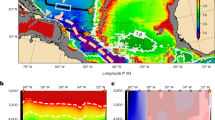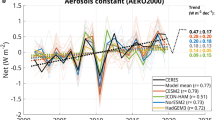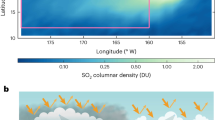Abstract
Atmospheric aerosol particles influence the climate system directly by scattering and absorbing solar radiation, and indirectly by acting as cloud condensation nuclei1,2,3,4. Apart from black carbon aerosol, aerosols cause a negative radiative forcing at the top of the atmosphere and substantially mitigate the warming caused by greenhouse gases1. In the future, tightening of controls on anthropogenic aerosol and precursor vapour emissions to achieve higher air quality may weaken this beneficial effect5,6,7. Natural aerosols, too, might affect future warming2,3,8,9. Here we analyse long-term observations of concentrations and compositions of aerosol particles and their biogenic precursor vapours in continental mid- and high-latitude environments. We use measurements of particle number size distribution together with boundary layer heights derived from reanalysis data to show that the boundary layer burden of cloud condensation nuclei increases exponentially with temperature. Our results confirm a negative feedback mechanism between the continental biosphere, aerosols and climate: aerosol cooling effects are strengthened by rising biogenic organic vapour emissions in response to warming, which in turn enhance condensation on particles and their growth to the size of cloud condensation nuclei. This natural growth mechanism produces roughly 50% of particles at the size of cloud condensation nuclei across Europe. We conclude that biosphere–atmosphere interactions are crucial for aerosol climate effects and can significantly influence the effects of anthropogenic aerosol emission controls, both on climate and air quality.
This is a preview of subscription content, access via your institution
Access options
Subscribe to this journal
Receive 12 print issues and online access
$259.00 per year
only $21.58 per issue
Buy this article
- Purchase on Springer Link
- Instant access to full article PDF
Prices may be subject to local taxes which are calculated during checkout





Similar content being viewed by others
References
Forster, P. et al. in Climate Change 2007: The Physical Science Basis (eds Solomon, S. et al.) 129–234 (Cambridge Univ. Press, 2007).
Carslaw, K. S. et al. A review of natural aerosol interactions and feedbacks within the Earth system. Atmos. Chem. Phys. 10, 1701–1737 (2010).
Arneth, A. et al. Terrestrial biogeochemical feedbacks in the climate system. Nature Geosci. 3, 525–532 (2010).
Mahowald, N. Aerosol indirect effects on biogeochemical cycles and climate. Science 334, 794–796 (2011).
Arneth, A., Unger, N., Kulmala, M. & Andreae, M. O. Clean the air, heat the planet. Science 326, 672–673 (2009).
Mickley, L. J., Leibensperger, E. M., Jacob, D. J. & Rind, D. Regional warming from aerosol removal over the United States: Results from a transient 2010–2050 climate simulation. Atmos. Environ. 46, 545–553 (2012).
Makkonen, R. et al. Air pollution control and decreasing new particle formation lead to strong climate warming. Atmos. Chem. Phys. 12, 1515–1524 (2012).
Quinn, P. K. & Bates, T. S. The case against climate regulation via oceanic phytoplankton sulphur emissions. Nature 480, 51–56 (2011).
Kulmala, M. et al. A new feedback mechanism linking forests, aerosols, and climate. Atmos. Chem. Phys. 4, 557–562 (2004).
Guenther, A. B. et al. A global model for natural volatile organic compound emissions. J. Geophys. Res. 100, 8873–8892 (1995).
Hallquist, M. et al. The formation, properties and impact of secondary organic aerosol: Current and emerging issues. Atmos. Chem. Phys. 9, 5155–5236 (2009).
Jimenez, J. L. et al. Evolution of organic aerosols in the atmosphere. Science 326, 1525–1529 (2009).
Leaitch, W. R. et al. Temperature response of the submicron organic aerosol from temperate forests. Atmos. Environ. 45, 6696–6704 (2011).
Tunved, P. et al. High natural aerosol loading over boreal forests. Science 312, 261–263 (2006).
Lee, A. K. Y. et al. Characterization of aerosol and cloud water at a mountain site during WACS 2010: Secondary organic aerosol formation through oxidative cloud processing. Atmos. Chem. Phys. 12, 7103–7116 (2012).
Riipinen, I. et al. Organic condensation: A vital link connecting aerosol formation to cloud condensation nuclei (CCN) concentrations. Atmos. Chem. Phys. 11, 3865–3878 (2011).
Riipinen, I. et al. The contribution of organics to atmospheric nanoparticle growth. Nature Geosci. 5, 453–458 (2012).
Pierce, J. R. et al. Nucleation and condensational growth to CCN sizes during a sustained pristine biogenic SOA event in a forested mountain valley. Atmos. Chem. Phys. 12, 3147–3163 (2012).
Dusek, U. et al. Size matters more than chemistry for cloud-nucleating ability of aerosol particles. Science 312, 1375–1378 (2006).
Clarke, A & Kapustin, V. Hemispheric aerosol vertical profiles: Anthropogenic impacts on optical depth and cloud nuclei. Science 329, 1488–1492 (2010).
Sihto, S-L. et al. Seasonal variation of CCN concentrations and aerosol activation properties in boreal forest. Atmos. Chem. Phys. 11, 13269–13285 (2011).
Seidel, D. J. et al. Climatology of the planetary boundary layer over the continental United States and Europe. J. Geophys. Res. 117, D17106 (2012).
Kulmala, M. et al. General overview: European integrated project on aerosol cloud climate and air quality interactions (EUCAARI)—integrating aerosol research from nano to global scales. Atmos. Chem. Phys. 11, 13061–13143 (2011).
Barnaba, F., Angelini, F., Curci, G. & Gobbi, G. P. An important fingerprint of wildfires on the European aerosol load. Atmos. Chem. Phys. 11, 10487–10501 (2011).
Després, V. R. et al. Primary biological aerosol particle in the atmosphere: A review. Tellus B 64, 015598 (2012).
Day, M. C. & Pandis, S. N. Predicted changes in summertime organic aerosol concentrations due to increased temperatures. Atmos. Environ. 45, 6546–6556 (2011).
Charlson, R. J., Lovelock, J. E., Andreae, M. O. & Warren, S. G. Oceanic phytoplankton, atmospheric sulphur, cloud albedo and climate. Nature 326, 655–661 (1987).
Hansen, M. C., DeFries, R. S., Townshend, J. R. G. & Sohlberg, R. Global land cover classification at 1 km resolution using a decision tree classifier. Int. J. Remote Sens. 21, 1331–1365 (2000).
Spracklen, D. V. et al. Aerosol mass spectrometer constraint on the global secondary organic aerosol budget. Atmos. Chem. Phys 11, 12109–12136 (2011).
Stevens, B. & Feingold, G. Untangling aerosol effects on clouds and precipitation in a buffered system. Nature 461, 607–613 (2009).
Acknowledgements
This work was funded by European Research Council (ATMNUCLE, 227463), Academy of Finland (Center of Excellence Program project 1118615; projects 11750, 127210, 132640 and 139656), European Commission sixth Framework program (EUCAARI, contract no 036833-2; EUSAAR, contract no 026140), European Commission seventh Framework program (ACTRIS, contract no 262254; PEGASOS, contract no 265148), Maj and Tor Nessling Foundation (projects 2010143, 2011200, 2012443 and 2013325) and the Otto A. Malm foundation. For providing data, we acknowledge the Physical Sciences Division, Earth System Research Laboratory, NOAA, Boulder, Colorado (for the boundary layer height data acquired from their web site at http://www.esrl.noaa.gov/psd/), the Hungarian Meteorological Service, Gerald Spindler, Pasi P. Aalto and Harald Flentje. We thank Ville Vakkari for help in quality assurance of Botsalano data and students and staff of North-West University (Mafikeng Campus), RSA, for weekly maintenance. The various measurements were supported by the German Federal Ministry for the Environment (FE 370343200), Environment Canada, NSERC, CFCAS-CAFC, the National Science Foundation (#0544745 and supplement, and 1102309), the Swedish Research Council (projects 2007-3745, 2007-4619 and 2010-4683) and the Swedish Research Council for Environment, Agricultural Sciences and Spatial Planning (Formas, project 2009-615).
Author information
Authors and Affiliations
Contributions
P.P. had the original idea; P.P. and A. Asmi made the data analysis; A. Asmi made the figures; M.K.K., T.H. and C.P-D. made the monoterpene concentration measurements and the data pre-analysis; M.Ä., H.J. and J.P.D.A. made the aerosol mass concentration measurements; A. Asmi, V-M.K., A.L. and P.R. made the calculations of the feedback strength; A. Arneth, W.B., A. Hamed, A. Hoffer, T.H., L.L., W.R.L., S.C.P., E.S., A.W. and T.P. provided the particle number size distribution and meteorological data; H.D.v.d.G. provided the anthropogenic emission inventory data; T.P., D.R.W. and M.K. supervised the analysis and writing; P.P., A. Asmi and V-M.K. wrote the paper; All authors contributed with their comments to the paper.
Corresponding authors
Ethics declarations
Competing interests
The authors declare no competing financial interests.
Supplementary information
Supplementary Information
Supplementary Information (PDF 1298 kb)
Rights and permissions
About this article
Cite this article
Paasonen, P., Asmi, A., Petäjä, T. et al. Warming-induced increase in aerosol number concentration likely to moderate climate change. Nature Geosci 6, 438–442 (2013). https://doi.org/10.1038/ngeo1800
Received:
Accepted:
Published:
Issue Date:
DOI: https://doi.org/10.1038/ngeo1800
This article is cited by
-
High-latitude vegetation changes will determine future plant volatile impacts on atmospheric organic aerosols
npj Climate and Atmospheric Science (2023)
-
Changes in biodiversity impact atmospheric chemistry and climate through plant volatiles and particles
Communications Earth & Environment (2023)
-
Recent seasonally contrasting and persistent warming trends in Latvia
Theoretical and Applied Climatology (2023)
-
Scattering and absorbing aerosols in the climate system
Nature Reviews Earth & Environment (2022)
-
Mechanisms and Pathways for Coordinated Control of Fine Particulate Matter and Ozone
Current Pollution Reports (2022)



